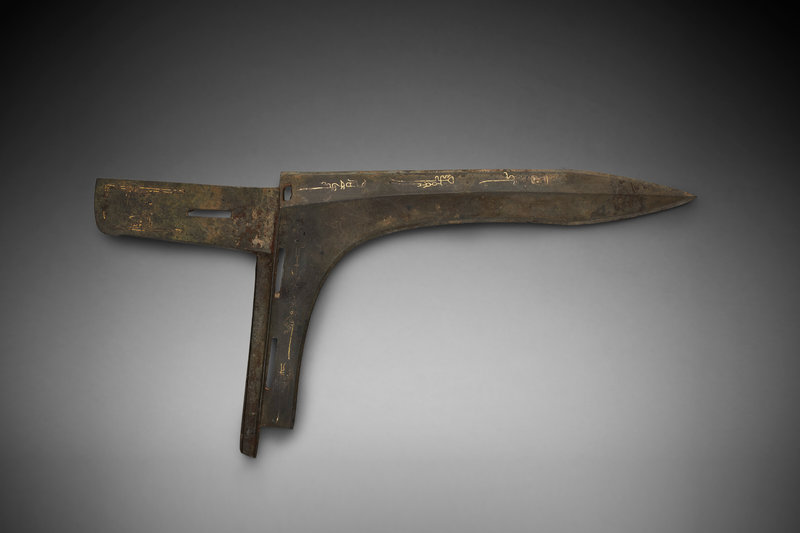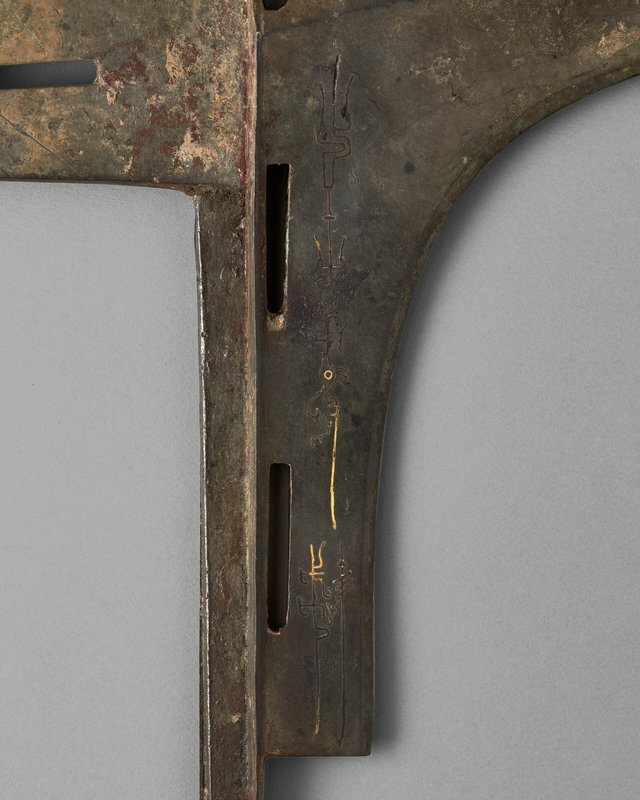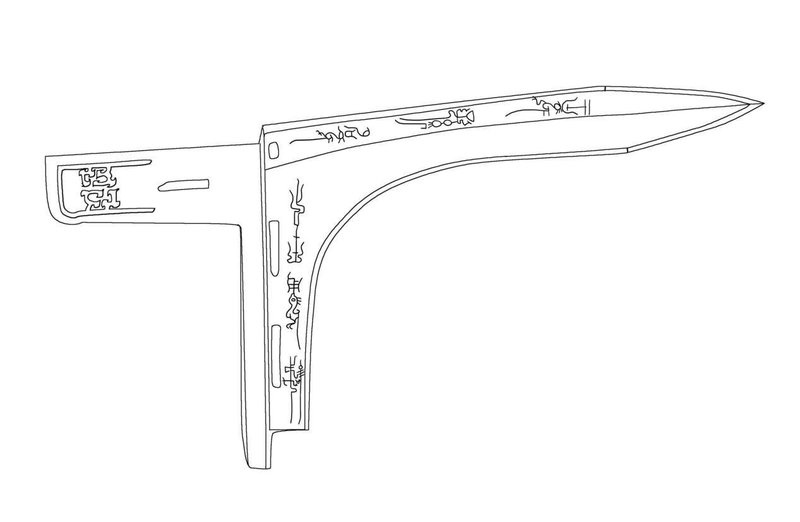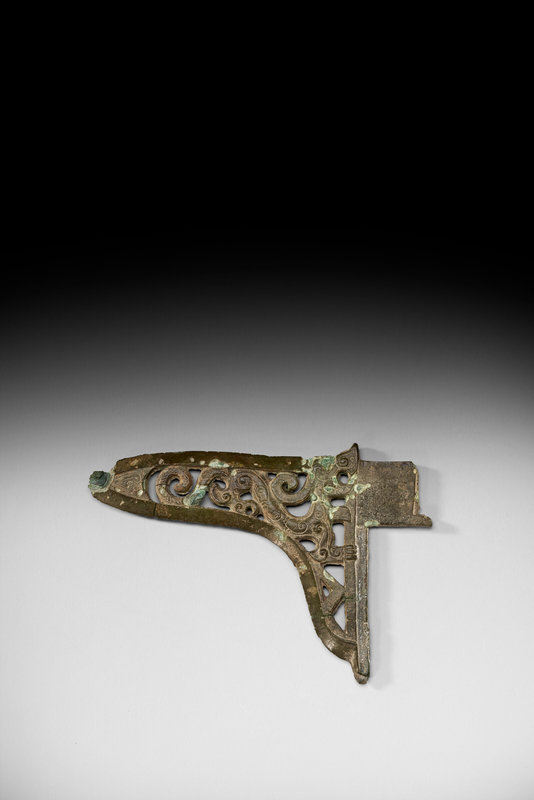Antique Bronze from J. J. Lally & Co. to be sold at Christie's New York, 23.03.2023
Lot 801. A bronze ritual tripod food vessel, ding, late Shang dynasty, Anyang, 12th-11th century BC; 9 1/4 in. (23.5 cm.) high. Estimate USD 80,000 – USD 100,000. Price realised USD 75,600. © Christie’s 2023
The deep body is raised on three columnar legs and is cast with a band of circular bosses alternating with kui dragons below the everted rim set with a pair of bail handles. The patina is of mottled olive-green color with areas of malachite encrustation on the interior.
Provenance: Caroline B. Carter Collection.
Estate of Caroline B. Carter; Sotheby's New York, 29 November 1993, lot 177.
J. J. Lally & Co., New York, no. 4637.
Note: A bronze ding of smaller size (15 cm. high), but of similar proportions and with a similar band of whorls and kui dragons below the mouth rim, from a Shang dynasty tomb in Guojiazhuang, Anyang, Henan province, is illustrated in Zhongguo qingtongqi quanji (Compendium of Chinese Bronzes), Beijing, 1997, vol. 2, Shang (II), no. 27. A similar band of whorls and very similarly rendered kui dragons can also be found on a late Shang gui sold at Christie’s New York, 14 September 2017, lot 904, and again at Sotheby’s New York, 17 March 2021, lot 192.
Lot 802. A bronze ritual tripod wine vessel and cover, you, late Shang dynasty, Anyang, 12th-11th century BC; 9 in. (23 cm.) high. Estimate 100,000 – USD 150,000. Price realised USD 100,800. © Christie’s 2023
The pear-shaped body is cast on the shoulder with a band of diamond-shaped leiwen centered on an animal mask in relief between borders of circles, and the rope-twist handle is attached to the narrow sides by loops. The domed cover is similarly decorated beneath a segmented finial cast with cicadas. The interior of the cover and the vessel is cast with an inscription probably reading wen fu mu and wen fu mu fu yi, respectively, and the base of the vessel is cast with a turtle design.
Provenance: J. J. Lally & Co., New York, 1993.
Dr. John T. Biggs (1942-1998) Collection, St. Louis.
J. J. Lally & Co., New York, no. 4641.
Note: The inscription cast inside the cover consists of the character wen, probably a clan sign, followed by fu and a character reading either mu or qi (Lady Mu or Lady Qi). The same inscription is cast in the center of the base of the vessel, with two additional characters, fu yi (Father Yi).
For a similar bronze you unearthed in 1970 from a Shang dynasty tomb at Anyang, Henan province, see Shang and Zhou Bronzes unearth from Henan Province, vol. I, Beijing, 1981, p. 198, no. 249, and the example in the Museum of Eastern Antiquities, Oxford, illustrated by W. Watson in Ancient Chinese Bronzes, London, 1962, pl. 23a. A larger bronze you (28.6 cm. high) dated 11th century BC of similar form and with similar decoration and rope-twist handle is illustrated by R. W. Bagley in Shang Ritual Bronzes in the Arthur M. Sackler Collections, Washington, D. C., 1987, p. 388, no. 68, where the author notes, p. 390, “The fine angular spirals that fill the decorated bands differ from leiwen by their arrangement in a regular pattern of triangles and rhombs… It was probably not created de nouveau near the end of the Anyang period but instead seems to have devolved from early Anyang designs of scorpions.” Bagley illustrates, p. 390, a bronze hu and cover in the Museum für Ostasiatiche Kunst, Köln, featuring a geometricized scorpion.
A turtle motif similar to that cast on the base of the present vessel can be seen in the center of a late Shang bronze ritual water basin (pan) from the Avery Brundage Collection, and now in the Asian Art Museum of San Francisco, illustrated by R. Y. d’Argencé in Ancient Chinese Bronzes in the Avery Brundage Collection, San Francisco, 1967, p. 38, pl. XIV:B. Another similar turtle motif can be seen in a rubbing of a late Shang bronze you illustrated by M. Hayashi, In Shu jidai seidoki no kenkyu (A Study of Shang Zhou Bronzes), vol. II, Tokyo, 1986, p. 294, no. 10-109.
Lot 803. A very rare gold-inlaid archaic bronze dagger-axe, ji, Eastern Zhou dynasty, circa 5th century BC; 10 3/8 in. (26.4 cm.) long, metal stand, Japanese double wood box. Estimate USD 30,000 – USD 40,000. Price realised USD 100,800. © Christie’s 2023
The slender blade is pierced with four rectangular apertures and is finely inlaid in gold in bird script on one side with three characters running horizontally along the upper edge of the blade and three further characters running vertically along the hu. The nei is cast on both sides with twin hooked scroll motifs within double line borders.
Provenance: Private collection, Japan.
Kochukyo, Tokyo, by 1995.
J. J. Lally & Co., New York, no. 4081.
Literature: Zhang Guangyu and Cao Jinyan (eds.), Dongzhou niaozhuan wenzi bian (Index of Eastern Zhou Bird-Script), Taipei, 1994, p. 33, no. 122.
Liu Binhui and Liu Changwu, Chu xi jinwen huibian (Compendium of Bronze Inscriptions of the Chu Culture), Wuhan, 2009, p. 23, no. 94 and p. 383, pl. 94.
J. J. Lally & Co., Ancient Chinese Bronzes, New York, 2011, no. 24.
Wu Zhenfeng (ed.), Shang Zhou qingtongqi mingwen ji tuxiang jicheng (Compilation of Bronze Inscriptions and Imageries from the Shang and Zhou Dynasties), vol. 31, Weapons: ge, ji, Shanghai, 2012, pp. 341-342, no. 16848.
Cao Jinyan (Ed.), Niao chong shu tongkao (Comprehensive Study of Bird-Worm Script), Shanghai, 2014, p. 397, no. 42 and p. 399, pl. 319.
Exhibited: New York, J. J. Lally & Co., Ancient Chinese Bronzes, 19 March-9 April 2011.
Note: The gold-inlaid inscription in bird script may be read as, Wang Sun Ming zhi yong ji (ji for the use of Wang Sun Ming). The name Wang Sun Ming is cited in Shang Zhou qingtongqi mingwen xuan (Selected Bronze Inscriptions from the Shang and Zhou), vol. 4, Beijing, 1990, p. 428, footnote no. 1, as being a person from the state of Chu.
According to Zhang Han in “Study on Gold Inlaid Bird Script Bronze Ge Daggers Unearthed from Wanrong,” Wenwu, 1962, nos. 4-5, pp. 35-36, this very decorative style of script is first seen on bronze weapons made in Southern China during the late Spring and Autumn period.
A set of three bronze daggers, comprised of a ji similar to the present example and two ge, was unearthed in 1978 from the tomb of the Marquis Yi of Zeng (c. 433-300 BC) in Leigudun, Suizhou, Hubei province, and is now in the Hubei Provincial Museum. Like the present ji, the three daggers are each inlaid in gold with an inscription in bird script reading, ‘Halberd for the use of Maquis Yi of Zeng’. The set is illustrated Zeng Hou Yi mu (Tomb of Marquis Yi of State Zeng), vols. I-II, Beijing, 1989, p. 267, no. 157 in. vol. I and pl. XCI in vol. II, and again in Zhongguo qingtongqi quanji: Dong Zhou, IV (Compendium of Chinese Bronzes: Easter Zhou, IV) vol. 10, Beijing, 1998, no. 170, with a description on p. 58. The set was published again recently by Fan J. Zhang and Jay Xu (eds.) in Phoenix Kingdoms: The Last Splender of China’s Bronze Age, Asian Art Museum, San Francisco, 2022, p. 155, no. 86, where a reconstruction of the weapon is also illustrated. As noted by Haicheng Wang in his entry for the set, the three blades were “originally mounted perpendicular to the eight-foot-long shaft of a spear. The one at top has a tang that extends through the shaft… The three blades were set in slots cut into the shaft and tied in place through slits in their long back edges… To avoid breakage, the shaft was made of a wooden core covered by bamboo strips and then wrapped with leather or rattan straps. It was further coated with lacquer and adorned with a horn fitting at its bottom.”
Lot 804. A bronze scribe’s knife, xiao dao, Warring States period, 4th-3rd century BC; 10 3/4 in. (27.4 cm.) long, cloth box. Estimate USD 5,000 – USD 7,000. Price realised USD 27,720. © Christie’s 2023
The slender curving blade has a very sharp edge which continues to the rounded tip, with the narrow fluted handle ending in an oval loop terminal. The burnished surface retains the original 'golden' tone of the bronze.
Provenance: Acquired in Hong Kong, 1998.
J. J. Lally & Co., New York, no. 2879.
Note: This distinctive type of knife, called a xiao dao, was used for preparing bamboo strips to be used as stationery for calligraphy written with brush and ink. Knives of this type are associated with Southern regions of China, around the Yangzi River basin.
A bronze knife of very similar form unearthed in 1965 from a Chu culture site northwest of Ji’nan, Hubei, and now in the Hubei Provincial Museum, is illustrated by J. Rawson in Mysteries of Ancient China: New Discoveries from the Early Dynasties, London, 1996, pp. 150-51, no. 69.
Another similar knife, but of smaller size, unearthed in 1978 from the tomb of the Marquis Yi of Zeng (d. 433 BC) is illustrated in the excavation report, Zeng Hou Yi mu (Tomb of Marquis Yi of State Zeng), vols. I-II, Beijing, 1989, pl. LXXXIV, no. 1 in vol. II. See, also, a related bronze knife exhibited at the Osaka Municipal Museum and illustrated in the catalogue, Chugoku Sengoku jidai no bijutsu (Chinese Art of the Warring States Period), Osaka, 1991, p. 101, no. 144.
Lot 805. A bronze ceremonial dagger-axe, Ge, Warring States Period (475-221 BC); 5 1/8 in. (13 cm.) long, softwood stand, cloth box. Estimate USD 4,000 – USD 6,000. Price realised USD 5,670. © Christie’s 2023
The dagger-axe is cast in openwork with a sinuous dragon framed by beveled edges. The surface has a pale grey-green patination.
Provenance: Collection of Alexandre J. Argyropoulos (1894-1978), Greek Ambassador to China, late 1940s-early 1950s, and thence by descent within the family.
J. J. Lally & Co., New York.
Literature: A. J. Argyropoulos, “The Chinese Ritual Bronzes,” The Connoisseur Magazine, London, February 1964, p. 94, pl. 9.
Christie's. J. J. Lally & Co., New York, 23.03.2023

/https%3A%2F%2Fprofilepics.canalblog.com%2Fprofilepics%2F1%2F0%2F100183.jpg)
/https%3A%2F%2Fstorage.canalblog.com%2F03%2F02%2F119589%2F96711876_o.jpg)
/https%3A%2F%2Fstorage.canalblog.com%2F11%2F31%2F119589%2F94773502_o.jpg)
/https%3A%2F%2Fstorage.canalblog.com%2F20%2F83%2F119589%2F94772815_o.jpg)
/https%3A%2F%2Fstorage.canalblog.com%2F26%2F72%2F119589%2F75604929_o.jpg)
/https%3A%2F%2Fstorage.canalblog.com%2F59%2F60%2F119589%2F26458628_o.jpg)

















/image%2F1371349%2F20240406%2Fob_b23648_434058570-1644317966338216-88086167391.jpg)
/image%2F1371349%2F20240403%2Fob_6d5ae7_dp-28103-001.jpg)
/image%2F1371349%2F20240229%2Fob_8f31f9_431013694-1625286614908018-33034430839.jpg)
/http%3A%2F%2Fstorage.canalblog.com%2F79%2F20%2F119589%2F129837997_o.jpg)